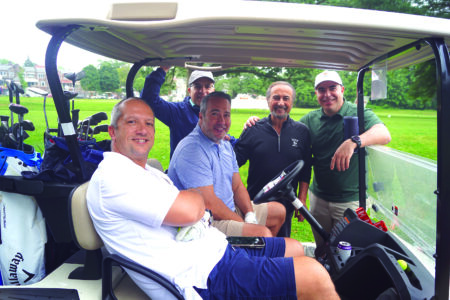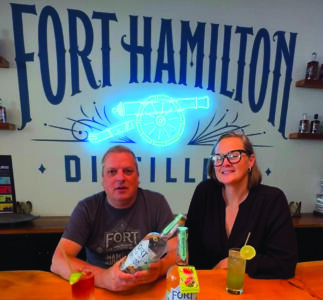Williamsburg’s incarnations of the Brooklyn Flea and Smorgasburg are due to reopen in the crisp open air of East River State Park in a few short weeks, on April 6, and with the arrival of the clothiers, cooks, carpenters, and other artisans will also come thousands of shoppers and eaters per day from around the city and world. Their energy, coupled with the entrepreneurship of the vendors and Flea founders Jonathan Butler and Eric Demby, is what continues to make the outdoor markets a must-see destination for residents, new businesses, and visitors alike.
But if the area around North 7th Street and Kent Avenue has become the hub, then how is that affecting the businesses and community around it? How are vendors/entrepreneurs expanding beyond the weekend markets? How are existing businesses affected? And what does this mean for Williamsburg going forward?
Growing Real Estate
One of the most visible changes in the immediate vicinity around the Flea’s waterfront space are, of course, new condo towers, restaurants, stores and art galleries that line Kent, Wythe, Berry, Bedford and Driggs Avenues, as well as a decent chunk of the North-numbered streets that intersect with them.
The creative energy and buzz factor in the neighborhood led to young professionals and families who couldn’t afford Manhattan or preferred Brooklyn’s community feel and up-and-coming status buying or renting condos inside the Northside Piers towers and The Edge, which in turn spurred businesses of all shapes and sizes followed to court the new customers.
“[The waterfront hub] played a huge part in us choosing our location,” admitted Eric Benaim, co-founder of real estate brokerage Modern Spaces NYC, which opened its first Brooklyn office/Sweetleaf coffee shop at 135 Kent Avenue, at North 6th Street, in 2012. “We knew that when people first come explore Williamsburg, they’re going to come first to the waterfront. So we wanted to be there at their entry point.
“I think [the market’s] impact is huge because they draw such a huge amount of people from outside the borough and neighborhood,” Benaim added. “Even tourists want to see the Flea or Smorgasburg, and for us, on Sundays, there are literally thousands of people on the street, a couple hundred [of whom] come into the store.”
Jennifer Johnsen was one of the many former Manhattanites whose visit triggered a decision to live in the neighborhood.
“I think people fall in love with Williamsburg when they come, like I did, for the day, and fell in love with the place and moved in two weeks later,” said Johnsen, who also works as executive director of sales at real estate brokerage MNS – which manages The Edge, which was named the top-selling residential building in NYC for 2012.
“We sold out [at the Edge] and we’re opening our new office right there because you get the East River Ferry and the Flea,” in addition to the building’s luxury amenities, she noted. “If we didn’t have those things, it would just be another place.”
On the other hand, “for residents, it’s a love-hate relationship,” explained the mom of two teens. “I love looking out my window and seeing vendors setting up and knowing it’s going to be a fun day, but then by the end of the day, the kids are trying to sleep and the trucks are honking at each other and the traffic is crazy.
“But without these kinds of things and the bohemian feel that the flea market brings, you would lose something about Williamsburg that’s really special, [such as] the incredibly talented artists. There are a lot of jewelers that make custom pieces, like bracelets with typewriter buttons that we fall in love with, who I would follow.”
Incubating businesses
Nicole Chaszar, chef and co-founder of The Splendid Spoon (formerly known as Sea Bean Goods), knows a little something about building a loyal fan base that will follow you on future endeavors.
Two years after opening her booth at Smorgasburg, selling her homemade, locally-sourced soups, the Greenpoint resident and French Culinary Institute graduate has an impressive soup-delivery business going, with bike messengers riding soup orders across Manhattan and North, Downtown and South Brooklyn. They even managed to get up and running shortly after Hurricane Sandy hit, while many other businesses were struggling from being waterlogged.
“I had a deep-seated urge to help nourish people during the week [when they might not be able to cook for themselves], but wasn’t sure about the business model, and loved the idea of being in an environment where I could interact with customers right away and around other food entrepreneurs,” explained Chaszar. “So for me, [Smorgasburg] was the only way to have a testing ground that felt like a valid testing ground.”
One of the special things about Smorgasburg and the Flea, she said, is how Butler and Demby’s application/curating process for potential vendors provides “validation” not just for her as a chef and business owner, but also for the customers. “It says something that these people have been selected and it’s a totally curated experience,” she explained.
Among the other market vendors who have also managed to strike out in other venues are Matthew Lief and Jakob Cirell’s Landhaus, which has a storefront restaurant in Park Slope during the cold-weather months (they alternate use of the space with People’s Pops, another Flea/Smorgasburg vendor) and Mighty Quinn’s BBQ, which expanded into their own shop in the East Village.
Business and Community Impact
Felice Kirby, co-owner of the 125-year-old unofficial Williamsburg landmark, Teddy’s Bar and Grill, said that compared to when she and her co-owners moved in over 30 years ago, the neighborhood “has a lot of positive community quality of life improvements, most especially access to the waterfront and parks due to community organizing” by groups such as Neighbors Allied for Good Growth, Open Space Alliance, and Friends of East River State Park.
“But there’s always a downside to progress [and] in the particular example of the Brooklyn Flea and Smorgasburg, the arrival of so much foot traffic,” said Kirby, “is a head-on competition for food and beverage business] for businesses. . . [that are located] a little bit off of the path.”
“In a sense, we’re competing with the New York waterfront and skyline,” she said, since the outdoor markets also sell alcoholic beverages and are all-day experiences that do “not [have] a lot of spillover from that concentrated business.”
Other activities, such as weekend and summer concerts, the return of the East River Ferry, and increasing “diversity of businesses” throughout the neighborhood do have a positive spillover, she said, adding that “events that use the waterfront to [attract] buyers to businesses should always give back benefits to the community nonprofits that are the defenders of our quality of life.”
Caitlin Dourmashkin, director of planning and community development at the East Williamsburg Valley Development Corporation (EWVIDCO), which also runs the Northside Merchants Association, agreed that the Flea is “just one of a few major generators of foot traffic in the neighborhood [as] businesses tend to see an uptick of business in the summer” in general, but the markets remain “a great foothold [for newer businesses] and also great for existing businesses to market themselves and test product.”
One effort to spread the success of the Flea to other area businesses in North Brooklyn is a small food program that includes “informational workshops and networking opportunities for local food manufacturers to help them grow.”
Provided by the EWVIDCO, the workshops and small food program was designed with help from “the people behind the Flea,” who are one of the many members of the merchants association.
Blueprint for the future?
For Butler and Demby, part of their larger goal is to expand further into Brooklyn, away from Williamsburg and DUMBO and their inaugural Flea site in Fort Greene – and into Crown Heights, where they are working on transforming the former Studebaker Service Station into a 150,000-square-foot kitchen and educational incubator for businesses in the technology, food, and other creative industries. The space will also include a “Smorgasburg-branded beer hall” and selected food vendors, as reported in The New York Times.
Outgoing Brooklyn Borough President Marty Markowitz has also gotten in on the business incubator action, having committed $1.5 million in 2011 towards the construction of a kitchen incubator in Central Brooklyn. In his 2012 State of the Borough address, Markowitz announced that Bushwick-based art and community center Third Ward had been selected by the NYC Economic Development Corporation as the manager of the incubator, which began construction in late 2012.
Add to that the fact that Bush Terminal and Industry City along the Sunset Park waterfront is home to dozens of food and light manufacturing businesses, and the Brooklyn Navy Yard continues to redevelop its historic buildings for mixed commercial and production use, and it becomes clear that the Brooklyn Flea/Smorgasburg brand is just one model in a larger blueprint being formed for a Brooklyn that has always been an incubator of entrepreneurial dreams.

 On the Avenue: Community golfs ‘fore’ good cause
On the Avenue: Community golfs ‘fore’ good cause  On the Avenue: Annual ‘Battle of the Bartenders’ to bring new cocktail to 3rd!
On the Avenue: Annual ‘Battle of the Bartenders’ to bring new cocktail to 3rd!